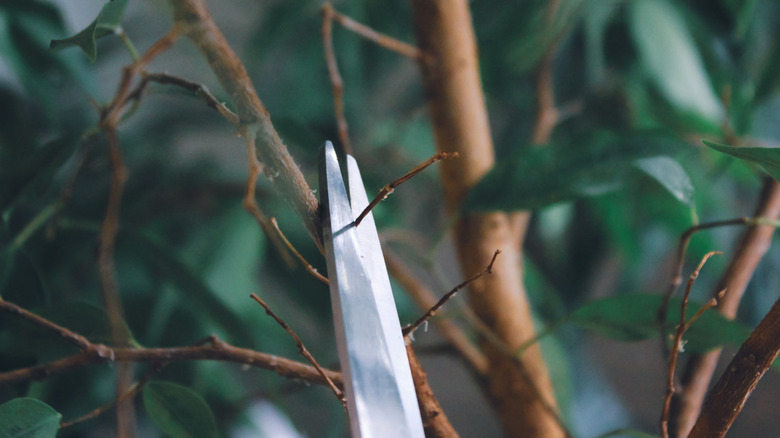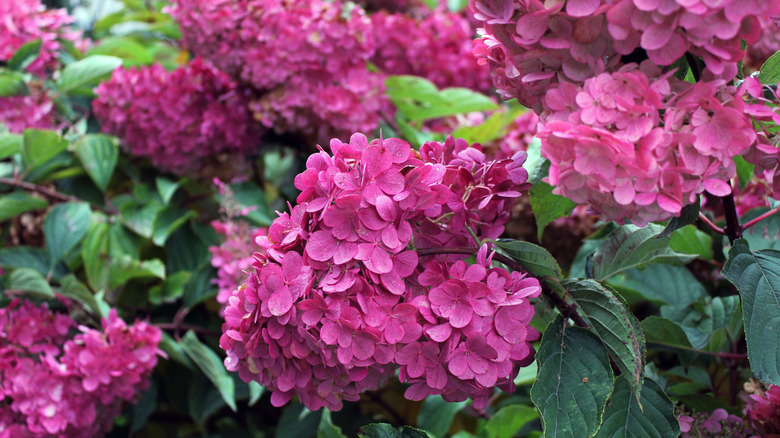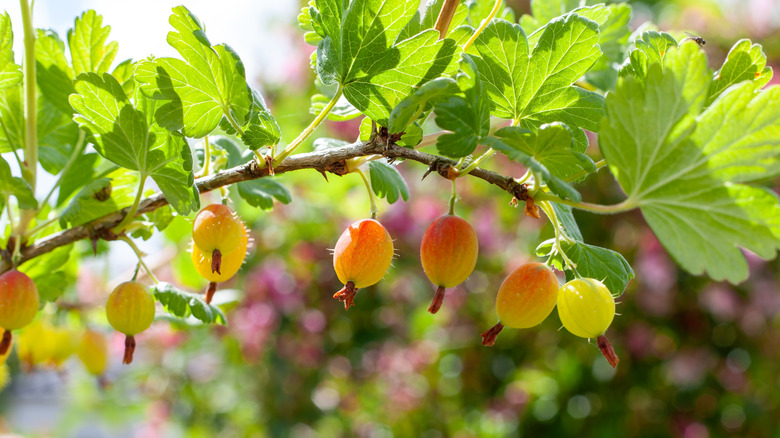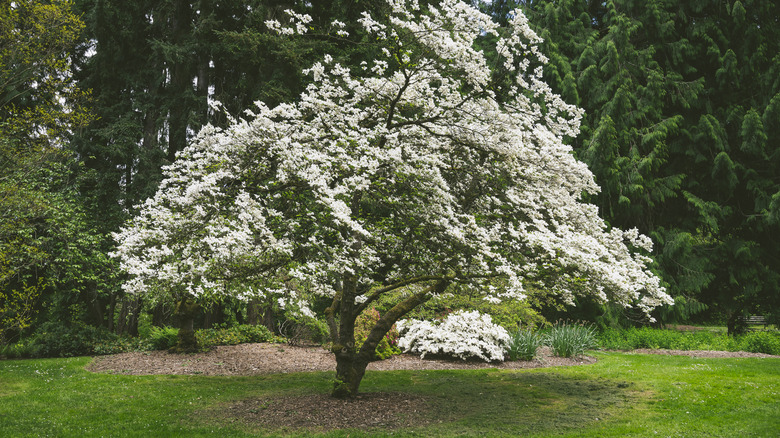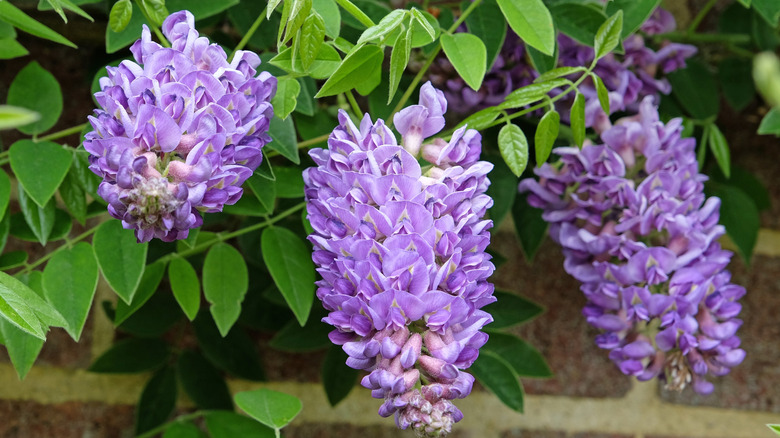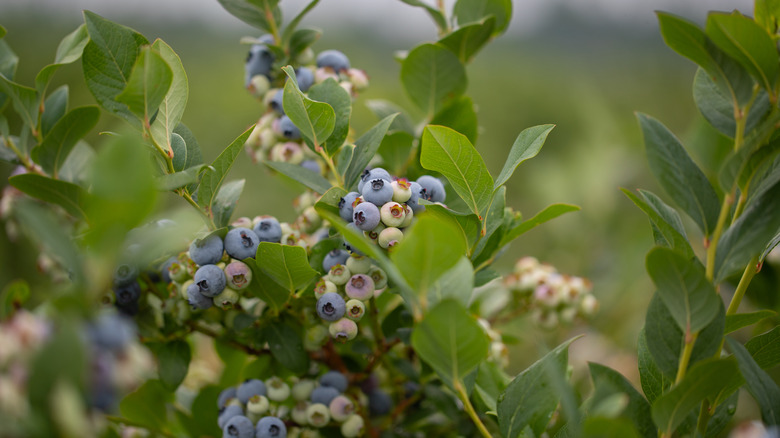Prune These 9 Shrubs In November For A Healthier Spring Landscape
November is the sweet spot to prune many of your favorite shrubs around the yard. With temperatures steadily dropping and perennials transitioning into their dormant state, you have a chance to give your shrubs a leg up in preparation for spring. Since the plants aren't actively growing at this time, pruning them won't cause as much stress. Shrubs bring depth and height variability to your landscaping, but without intervention, they might sprawl out wildly in all directions or grow leggy. Shrubs such as hydrangeas, roses, and tree peonies all benefit from late fall pruning.
As tempting as it may be to pause your gardening chores until spring, you'd be missing a major opportunity to cultivate a healthier and more beautiful outdoor sanctuary. When you prune your shrubs in November, it not only gives them a more attractive shape, but it also helps to encourage healthy growth come spring. Shaping up your shrubs also allows for better airflow, helps prevent disease, and allows for more sunshine to make it through to smaller plants in the summer. When you're ready to prune, use sharp, clean shears to trim off dead or diseased branches. Once you're done with that, you can focus more on shaping your plant. Be sure to avoid pruning any new growth so you don't inadvertently trigger tender shoots to develop — these won't be hardened enough to survive the winter. If you have any of these 9 shrubs in your yard, be sure to prune them in November.
Hydrangeas
November is a great time to prune hydrangeas (Hydrangea spp.). However, it's vital to understand which variety of hydrangea you're tending to. If you're not careful, you could jeopardize their blooming potential in the spring. Some hydrangeas bloom on old wood and others on new growth. You can prune new wood hydrangeas with ease in late fall, but you run the risk of cutting off next season's blooms when you trim an old wood hydrangea at this time. If your shrub blooms on old wood, skip pruning until right after the flowers fade in early fall.
Gooseberry
If you're a fan of tart, wild fruit, you might have a gooseberry (Ribes spp.) shrub in your yard. November is a great time to trim up summer-fruiting shrubs in preparation for the next growing season. Prune away dead, damaged, or diseased branches first and then turn your focus on older shoots. You'll want to keep a number of shoots that are between one and three years old, but remove any canes that are beyond three years old to make way for better airflow and sun penetration.
Roses
Roses (Rosa spp.) are a timeless garden staple with a lengthy list of care needs. Trimming throughout the year is essential for optimal growing potential as well as a prolonged blooming season. November pruning offers its own unique benefits, and cutting your rose plant back will help prevent wind damage, too. Be sure to wear elbow-length gloves to protect yourself from thorns and prune with sharp shears. Focus on dead, damaged, or diseased branches first. Then, depending on the type of rose, you can trim back the canes by one to two-thirds.
Butterfly bush
There's some debate on the best way to care for a butterfly bush (Buddleia davidii), with gardeners disagreeing on when to prune. As it turns out, it actually depends on its size and your climatic zone. It's a good idea to cut it back by no more than half if it's more than 4 feet tall. If you live in a temperate region, save pruning for spring, but in colder zones, the top of the bush can often die back. In that case, trim off the dead stems for a more attractive winter landscape.
Serviceberry
Prized for its spray of delicate, white flowers, the serviceberry (Amelanchier spp.) is a multi-trunked shrub and a relative of the rose. It's best to prune once the plant goes dormant in the fall to avoid excess sap loss. This is a great practice to increase air flow and sun penetration, as well as prevent diseases such as powdery mildew. When pruning, trim off any dead or damaged branches as well as any that are crossing over other ones. You can also remove any suckers and shape your serviceberry in November.
Wisteria
While often grown as a vine, wisteria (Wisteria spp.) can also be trained and pruned as a shrub. It's essential to prune twice a year to properly grow and care for your wisteria – once after flowering and once during its dormancy. In the fall, you'll want to focus on thinning out the plant to make way for new growth in the spring. Take this time to cut shoots to 2 or 3 buds. Keep in mind that some types of wisteria are invasive, but there are native species, such as American wisteria (Wisteria frutescens), you can grow instead.
Blueberry bush
Blueberries (Vaccinium spp.) are a high-yielding fruiting shrub ideal for many landscapes. You can leave your plant as is if you just planted it in the last two years. If you want, you can trim lateral shoots or shape it up in the fall. However, mature plants greatly benefit from pruning. When done properly, it promotes more fruit growth. Once the plant goes dormant, you can remove anywhere from a quarter to one-third of the shrub's old wood. You can also take this time to remove older branches at the center for better air flow.
Christmas rose
The Christmas rose (Helleborus spp.) is a long-living perennial that isn't actually a part of the rose family but is in the Ranunculaceae family. This flowering shrub typically blooms in late winter. Pruning this plant in November aids in preventing fungal diseases as well as paves the way for new foliage. Use sharp shears to carefully remove each old leaf stem in a clump. From there, you can continue to clean up your Christmas rose throughout the year as needed.
Tree peony
While a majority of peonies are considered herbaceous perennials, tree peonies (Paeonia x suffruticosa) are categorized as a deciduous shrub. Growing up to 6 feet tall and sporting large, showy blooms, these add structure and depth to a landscape. Right as the plant starts to go dormant around November, you can trim up your tree peony. Just limit your pruning to less than one-third of the plant and save the rest for spring. If you prune it too aggressively, you may inadvertently put too much stress on the plant.
